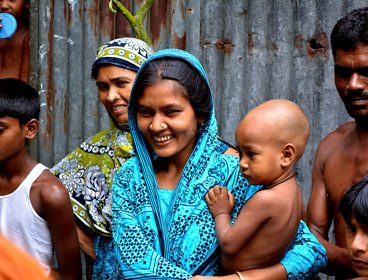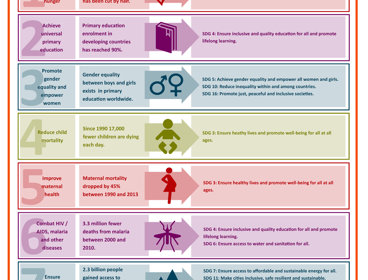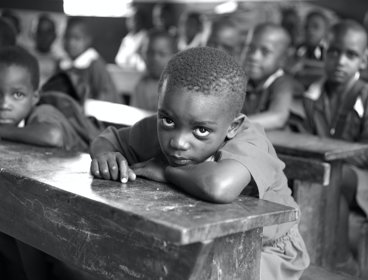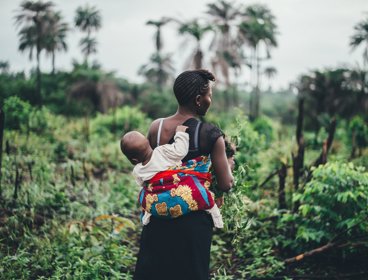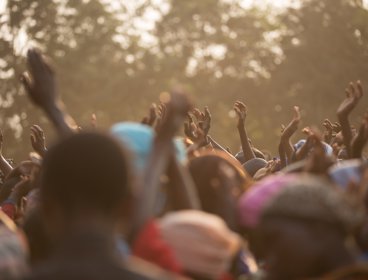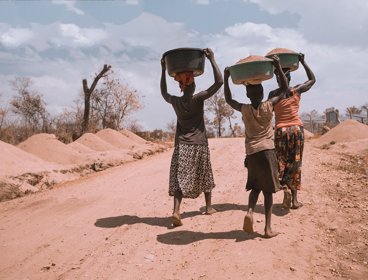Nick Danziger's photographic exhibition, Revisited, explored the impact that the United Nations Millennium Development Goals have had on the lives of people he had previously visited.
In 2005 you were commissioned by World Vision, to create an archive of photographs documenting the lives of women and children in eight countries across the world. The idea behind this was to see if and how their lives would change in the light of the targets set out by the United Nation’s Millennium Development Goals (MDGs), goals which aimed to eliminate poverty by 2015. Was the intention therefore always that you would revisit these people to see if there had been changes due to the MDGs, or was it your decision to retrace your original journeys and try to trace these people?
The original assignment was a one-off visit, there was no mention or thought in 2005 of returning to the same people at a later date. It didn’t immediately occur to me that it would be a good idea to return to see how the same people’s lives might have changed in the light of the United Nation’s Millennium Development Goals.
How many individual stories did you document from your original 10 week photographic journey? The photographic exhibition, eight, included 40 images, does that mean there were 40 individual stories?
There were more than 40 individual people, but not more than 40 stories. Sometimes there was a single story around one person, at other times there was one or several stories around a family or a group of people. This was the case for the four orphaned sisters, Gloria, Judith, Miriam, and Monica in Uganda. Originally the idea was to feature one MDG per country, but very quickly I discovered that, as in the case of the Ugandan sisters, they fell in to several MDGs – this was often the case.
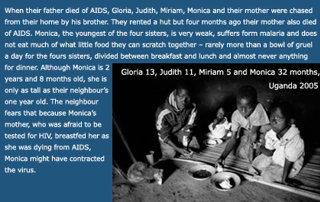
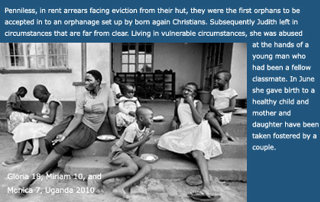
Gloria, Judith, Miriam, and Monica in Uganda 2005
How were the people whose lives you documented, chosen and what were their views on you photographing them?
There were many different ways as to how the people were chosen. However, they were mostly chosen with the help of local people who pointed me in the direction of people they knew. Sometimes I met groups of people and listened to their stories and then made a decision to follow one or several of them. Sometimes, as in the case of Chariya in Cambodia, we walked past her and seeing that she seemed unwell, we asked if she was okay. I only chose people who understood and agreed that I would try and document something of their lives. In several cases, I chose to document someone who I happened to come across fortuitously, usually seeing them in a certain situation, but again only with their permission. “What were their views on you photographing them?” I think it would be best if you asked them. Some were puzzled that I would be interested in them; others were shy, or embarrassed. I think the relationship changed when I revisited them. Most seemed very happy that I should have returned. A few seemed indifferent, in possibly one or two cases, particularly those who had suffered further deprivations or had become ill, such as Bridget in Zambia, who hoped that I could help her change the course of her very difficult situation.
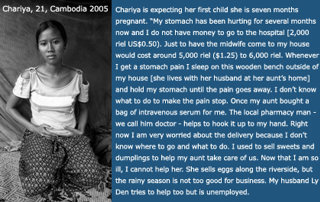
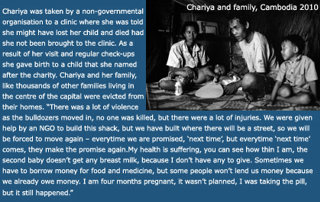
How were you affected by the stories of these people’s lives that you heard?
This is very difficult to answer - several of the people I photographed in 2005 had died prematurely by the time I returned 5 years later. How could I not be affected? What can I say that does not sound trite? Frustration – yes: that more is not being done to help the people that the MDGs are meant to be helping. Anger – yes: how is it possible that Husseini and Hussaina, twins, babies, died of hunger, because their aunt couldn’t afford to buy milk powder. This in the 21st Century. I see tomes and tomes of reports and analysis with graphs and colour coded charts that talk about which countries are likely to meet certain MDGs, which ones are slipping back – it all seems so abstract (and costly) when you see the reality on the ground. I hope these reports go to allocating or re-allocating resources where they will make the most difference.
Before embarking on the Revisited project, did you have any idea of what you might find?
I was not sure: I suppose the cliché 'hoping for the best, fearing for the worse’ was in my mind.
Did you try to revisit all of the original people in all eight countries? How did you manage to locate them all, as some have moved on? Had you remained in contact with any of the people since your first visit?
Yes, I did try and revisit all the original people. Remarkably, there were only two I did not find. One because the person had moved on and was going to require a lot of other people’s time to find and it was going to be very costly to get to her. Rakia, the other person I didn’t find after searching for her was found several months after I left the country which was very disappointing for me. In all the cases, I had a tremendous amount of help on the ground, without that it would have taken me a lot longer. In many instances this was a remarkable partnership with the people who had helped me in 2005. Quite a few of the people I had worked with in 2005 had moved on to new jobs, in two cases they had become unemployed, but they agreed to help me search for the people I was trying to trace. I have mainly stayed in contact with the people who originally helped me.
What progress, if any, did you see on your return journeys?
There is progress. Schools have been built – and more importantly are being attended by children in villages where there were no schools and there are health facilities where none existed before, but for many people I photographed in 2005, this has come too late for them to benefit. This for example was the case for Abbas in Niger, there is now a school in his village, but he is too old to attend. Tradition is also holding people back from attending school – again in Abbas’s case, he has taken a school age wife, but he does not want her to go to school, “I want a girl who is not wise and does not know the ways of the world so that I can control her and so she will not be influenced by what I have seen [the mining village].”
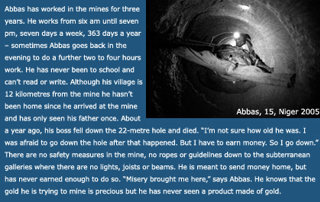
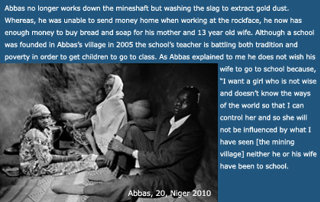
Did you feel that any of the positive changes in people’s situations could be directly attributed to the MDGs being followed more in countries or were the changes due to the individual person making changes if they were able?
Yes, some of the positive changes have definitely occurred as a result of the MDGs. Many countries are trying to overcome huge obstacles to meet these targets. Sadly, in some cases this has meant that the targets have resulted in sacrificing quality for quantity, I witnessed this in northern Uganda where classes often have over 100 pupils per class.
What can be attributed to the MDGs versus individuals making the changes? Difficult to quantify, one example comes to mind where both have come to be in the same village in the province of Bolivar in Bolivia, some children were being taught in a recently-built school through a government partnership with an international aid organisation (MDG 2 – universal primary education), whilst parent’s I had photographed in 2005 had decided, on their own initiative to educate their school age children by selling part of their livestock and with the proceeds sent them to the city to be schooled rather than sending them to the recently-built village school.
Did you see any progress that had been made when visiting these countries, i.e. did you witness projects that were in place or improvements because of the MDGs?
As in the previous question, yes in some countries I definitely witnessed projects that were likely to improve the quality of people’s lives, but I cannot say how much is as a result of targets laid out in the MDGs.
From what you saw and witnessed, what do you feel was promoting development, or holding it back?
From a personal viewpoint, in some countries, where democracy has a foothold and where people represented a possible constituency of potential voters, this was more likely to promote development rather than the MDGs. I think the biggest barriers to holding certain developments back are extreme poverty, tradition and lack of access to education.
Do you think that by 2015 the goals will have been met?
Many goals in many countries will not be met – but this is not a reason to lay down arms. Much, much more can be done: those that could be most helped, where a little input could result in a dramatic change in the quality of their lives, they are likely to be the first casualties in the global squeeze on funding.
How did people you managed to trace and visit feel about being ‘revisited’? How did they feel their lives were now in relation to five years previously?
As mentioned above, most seemed or expressed great surprise and happiness that I should be back. As to how they felt their lives had changed in the previous five years, no two people gave the same answer. Given the number of people I visited across eight countries on four continents I would say the range was from it has gotten worse to it is much better… in many cases the answer was also nothing has changed.
What stories did people want to share with you?
Again, different people wanted to share different aspects of their lives. Abbas wanted me to meet his mum and his new wife, Bridget, wanted some help with her eyes that were causing her great discomfort. I suppose most wanted me to share their families with me.
Did you feel the situation in some countries were better or worse than before?
Yes, some countries, or particularly the part of the country I visited were doing better than before. I don’t think anywhere was doing worse, just as badly, would be a fairer description.
Do you hope to try and visit these people again either before or after 2015 to see what, or if, other changes there have been?
I definitely want to revisit all the same people again – I want to know how Gloria, Judith, Miriam, and Monica are doing – presumably they might have moved, but I doubt they will have left Uganda, but who knows? I would like to know how Abbas and his young wife in Niger are faring – will she have borne a child? Will Eugenia, the former teenage llama herder’s schooling have changed the course of her life? I am sure each and every one of the people I photographed will have an important story to tell. I would like to do this in 2014 so that we can all share their stories in 2015 the end date of the MDGs. I am not sure how I will go about funding this? Revisited in 2010 took two years of fundraising – so I will soon be starting to fundraise again and looking for places to exhibit these extraordinary people and their stories.
All images copyright of Nick Danziger.
Nick was interviewed in March 2012.
The United Nations Millennium Development Goals are eight goals that all 191 UN member states have agreed to try to achieve by the year 2015. The United Nations Millennium Declaration, signed in September 2000 commits world leaders to combat poverty, hunger, disease, illiteracy, environmental degradation, and discrimination against women. The MDGs are derived from this Declaration, and all have specific targets and indicators.
The eight Millennium Development Goals (MDGs) – which range from halving extreme poverty to halting the spread of HIV/AIDS and providing universal primary education, all by the target date of 2015 – form a blueprint agreed to by all the world’s countries and all the world’s leading development institutions. They have galvanized unprecedented efforts to meet the needs of the world’s poorest.
The eight Millennium Development Goals:
-
Eradicate extreme poverty and hunger
-
Achieve universal primary education
-
Promote gender equality and empower women
-
Reduce child mortality
-
Improve maternal health
-
Combat HIV/AIDS, malaria and other diseases
-
Ensure environmental sustainability
-
Develop a global partnership for development
"Eradicating extreme poverty continues to be one of the main challenges of our time, and is a major concern of the international community. Ending this scourge will require the combined efforts of all, governments, civil society organizations and the private sector, in the context of a stronger and more effective global partnership for development. The Millennium Development Goals set timebound targets, by which progress in reducing income poverty, hunger, disease, lack of adequate shelter and exclusion — while promoting gender equality, health, education and environmental sustainability — can be measured. They also embody basic human rights — the rights of each person on the planet to health, education, shelter and security. The Goals are ambitious but feasible and, together with the comprehensive United Nations development agenda, set the course for the world’s efforts to alleviate extreme poverty by 2015." United Nations Secretary-General BAN Ki-moon
Nick Danziger's biography
In 2005, photographer, Nick Danziger travelled to eight of the world’s poorest countries to highlight the challenges faced by people living in extreme poverty. In 2010 the Royal Geographical Society (with IBG) awarded Nick the Neville Shulman Challenge Award to return to these countries to see whether the United Nations Millennium Development Goals (see the end of the questions for further information on these) were having positive impacts and see if life had changed for the people he met on his original journey.
Though perhaps most well-known for his intimate photographs of Tony Blair on the eve of the Iraq war, Nick Danziger has spent much of the last 25 years photographing some of the world’s most dispossessed and disadvantaged people. It was this interest that led him to focus on the Millennium Development Goals, and in particular on the question of whether they have achieved tangible benefits for the people they are aiming to help.
In 2010 Nick traveled to Armenia, Cambodia, India, Niger and Zambia, trying to track down the people he photographed during his first visit. The stories these people told of their lives in the intervening five years reveal both the massive strides that have been made and the obstacles that remain to be overcome. In India, AIDS treatment appeared to be improving, with free antiretroviral drugs now widely available. An orphanage for HIV+ children that Nick photographed on the outskirts of Chennai, India, in 2005, had after many rebuttals found a school willing to integrate the children into the education system.
Whilst in Armenia, a young teenager that Nick photographed was now a young mother, living alone in a single room with no heating or running water while her husband works in Siberia to support them. She moved away from her family so as not to be a burden on them, and could not see a way out of her plight.
Nick’s Revisited photographs were exhibited the Royal Geographical Society (with IBG) in January 2012.
Nick’s full biography can be read on his website.

